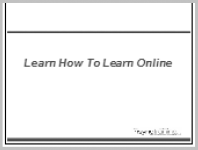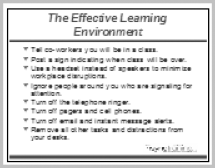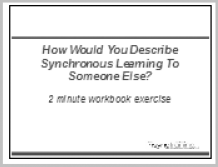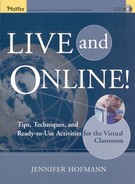Before designing or delivering synchronous courses, it is helpful to understand the learner experience. Learn How to Learn Online focuses on learning in the synchronous environment. It demystifies the technology for the participants so that they have a positive learning experience. The program explores the use of synchronous collaboration tools (whiteboard, chat, audio, and so on), synchronous learning ground rules, and creating the optimal environment for online learning. This session is a prerequisite to all other sessions.
At the conclusion of this session, participants will be able to
Explain a synchronous learning experience
Explain the role of the learner in the synchronous environment
Create an effective desktop learning environment for themselves
Effectively participate in a synchronous learning environment using basic collaboration tools
Prior to Class
Schedule class
Send out invitations
Enroll students (if applicable)
Distribute participant prework (if applicable)
Rehearse
Day of Class
Log on 30 minutes early
Load appropriate software slides (Placeware, Vclass) as well as LHTLO slides
Verify URLs are still valid
Test audio
Make sure the Introduction slide contains the correct photos and information
Enable recording
Following Class (If Applicable)
Send evaluations
Send follow-up work
Post discussion questions
Monitor discussion questions
Description, Timing, Media | Facilitator Notes | Producer Notes |
|---|---|---|
Getting Ready to Learn Online (Pre-Event Warm-Up) 15 minutes before start of "class"  | Write your class start time here: ____________ Make sure you start exactly on time. |
Say: If you're waiting to do an audio check or have already completed yours, please choose a whiteboard tool (such as pen, text, drawing) and sign our autograph book. Say: Then, in the chat area, tell us your full name (because we can only see your username and sometimes that is different or quirky), where you work, and what attracted you to this class. |
Learn How to Learn Online 10 seconds  | Make sure you start exactly on time. Say: Thank you for coming and welcome to Learn How to Learn Online! We hope at the end of this class you'll have the tools and knowledge you need to become an effective online learner. | |
Introductions 1 minute  | Say: You all had a chance to introduce yourself in the direct messaging area prior to class. I hope you took the opportunity to read about your fellow participants. I am your facilitator: ______________ (Title) _________________________ (Experience) __________________. And I'm here to help you become a successful synchronous learner. Now, I'd like to introduce you to the producer of today's session. | Highlight the email address on screen, as the teaching staff is introduced: |
Say: Hi, my name is: ____________ I am here to support you during today's session. Please send me a message in the chat area if you are experiencing technical problems or have logistical questions. I also will be helping (the facilitator) to manage exercises. | ||
Software-Specific Orientation 10 minutes  | Explain how to use the basic communication features of the software platform. Give participants an opportunity to practice. For example, to teach them how to raise their hands, show the slide that has the raise hand icon, mention where it is located on the screen, and ask them to raise their hands. | As features are identified on the whiteboard slides, use the tools to highlight each item. When possible, use arrows to point out the approximate position on the screen. |
Ground Rules 5 minutes  | Call on participants arbitrarily. Ask them to select a ground rule (no order necessary) and explain why it is important. Add additional comments as appropriate. Turn off email and phones and clear other distractions away from your training area. This is important because it is easy to answer the phone or pick up some work and lose track of what is going on in the class. The facilitator will not know that you have "checked out" so he or she won't be able to re-engage you successfully. Participate and prepare to be called on by name. This is important because the synchronous environment lends itself to interaction. Participation will keep you engaged and move the class along. If participation is low, the facilitator needs to be able to call on people without physical cues. Raise your hand if you have an immediate question or comment. When you click the "raise hand" button on your screen, an indicator appears next to your name. This is important because the facilitator cannot tell by looking at you if you are confused on a particular point or have something to add. Be patient waiting for a response to your chat messages. This is important because the facilitator can't do everything at once. You need to be patient and trust that you will receive a response to your notes. If you leave the program, please send a chat to the facilitator when you leave and when you return. This is important because the facilitator needs to know if he or she can call on you—and needs to know that you are not having technical difficulties. | Highlight the important words on the ground rule slide. Use consistent highlights here in order to engage left-brained thinkers (same color, same tool, same highlighting method). |
Ask Participants: What other ground rules would you suggest? Ask participants to answer the following poll question: Which is the ground rule you will find the most difficult to adhere to today? Indicate your vote by selecting A, B, C, D, or E. | For Vclass show the A–E polling choices. In other software applications a poll may need to be created. | |
What Might Keep You from Being a Successful Online Leaner? 1 min to explain 1 min for participants to answer 8 min to debrief  | Ask participates to raise their hands. Tell participants to note the number next to their hand. Direct their attention to the grid. Tell them the box that corresponds to their number is "their box." Say: you're going to have one minute to answer the question in the whiteboard grid, using the whiteboard tools. You may use the text tool, pen, picture, or whatever, but be ready to explain it! Ask: What might keep you from being a successful online learner? Say: If you have any questions about using the whiteboard tools, please raise your hand. Say: When you are done, indicate this by checking "yes." Debrief: Say: Now let's vote on those items we want to hear more about. Review each block in the grid and put a checkmark in one block that you would like to hear more about. Pick top five "popular" boxes. Note: Participants should keep their comments to 30 seconds Debrief: Call on one participant and ask him or her to explain what he or she meant. If you have helpful comments, make them. Continue with all remaining participants. Conclude: So there are a lot of barriers to learning online. A lot of these issues have to do with learning at your desk. So now let's explore some ways to make your desktop environment more conducive to learning. | Note: there are two grids in the slide deck. Choose the appropriate slide. If registration is 12 or less, choose the first grid; if 13 to 20, choose the second grid. After the exercise starts, lower everyone's hands. Respond to anyone who has raised his or her hand to indicate experiencing trouble with the whiteboard tools. Keep track of time and give people a 15-second warning. Clear all the "yeses." |
What Ideas Do you Have to Make Your Own Environment More Effective? 5 min  | Direct participants to answer the question on the slide by using the chat area. Say: list as many ideas as possible! Tell them that they have up to 1 minute to complete this exercise and that they should click "yes" when they are ready. (If appropriate: inform participants to make sure they are sending their messages to "all" participants.) Tell them that if they finish early, they should take the opportunity to review the comments posted by other participants. Call the end of the exercise. Tell participants they have an additional 15 seconds to read the other responses. Debrief: Select a few ideas and ask the participant to explain in more detail. Do this with up to five comments. Make additional comments about commonality, differences, good ideas, and so on, if appropriate. Conclude: Let's take a look at some very specific ways for you to have a successful learning environment. | Give a 15-second warning. Clear all yeses when participants are done. |
The Effective Learning Environment 10 minutes  | Say: Ideally, participants should be in private rooms while participating in a synchronous environment. In reality, most participants will learn from their desks. To learn effectively from their desks, participants need to:
Encourage participants to share anecdotes if they have any. | Check off points as they are covered. |
Role of the Participant in a Synchronous Class 5 minutes  | Say: Since kindergarten, or even earlier, we have been learning in pretty much the same way. We go to the teacher's location, we watch and listen to the teacher, and when we leave, we have learned something. (That's the theory, anyway.) We send signals to the teacher by nodding our heads, raising our hands, yawning, and changing our faces to express understanding, confusion, doubt, and a myriad of other emotions. We know how this works, and we understand our role in the process. Now picture a new synchronous participant—let's say it is you. After 20+ years of learning in the traditional manner, you are entering the world of synchronous learning. Let's assume you are willing and able to give this environment a chance. Here is what you have to contend with:
So do you have a chance? Will you learn anything? Will those around you take the fact that you are in training seriously? Your experience will have much to do with the tools and training you were given prior to the event. In essence, you need how to learn how to learn all over again. Now we have changed all the rules. | Annotate screen as appropriate. |
How Would You Describe Synchronous Learning? 8 minutes  | Say: For the past hour or so, you've been participants in a synchronous learning event, many of you for the first time. You probably have an altered perception of what it is, now that you've experienced it. Here's the scenario: You're going to go home tonight and tell your spouse you participated in your first synchronous learning event. And your spouse will say, "HUH?" How would you explain it to him or her? Go to your workbook (page 3) and take 2 minutes to answer this question. Click yes when you are done. Be prepared to share your answer with the class. Debrief: After the 2 minutes are over, select a participant at random and ask him or her to read the explanation. Comment yourself and ask for audience input. Repeat with two more participants. Ask: Does anyone have anything different to share? | Give 30-second warning. Clear the yeses when the exercise is over. Capture participant's explanation on whiteboard. Include speaker's name. Change font color for each speaker. |
AHA! 4 min  | Ask participates to raise their hands. Tell participants to note the number next to their hands. Direct their attention to the grid. Tell them the box that corresponds to their number is "their box." Say: you now have 30 seconds to write one "AHA" you experienced in this session. It can be positive, negative, or emotional. It may relate to the content, the technology, the experience, or your own organization. | Note: there are two grids in the slide deck. Choose the appropriate slide. If registration is 12 or less, choose the first grid; if 13 to 20, choose the second grid. After the exercise starts, lower everyone's hands. Clear all the "yeses." |
 | You may use the text tool, pen, picture, or whatever you wish, but be ready to explain it! Say: When you are done, indicate this by checking "yes." Wrap Up: Choose three or four "AHas" and make encouraging and supportive comments. Ask: Does anybody have any questions before we wrap up? Conclude: Today you've started on the road to becoming successful online learners. We've explored many of the tools available in most synchronous classrooms (there are more, such as application sharing and breakout rooms) that we didn't demonstrate today. We certainly hope we will see you online again in future events. You will be receiving an online course evaluation within 2 hours. Please complete that evaluation as soon as possible. We value your feedback. InSync Center offers a variety of free and fee-based courses that can help you improve your online learning and online training skills. If you have a question about these or any other programs, please send your questions to [email protected]. | Write questions and answers on screen. |
